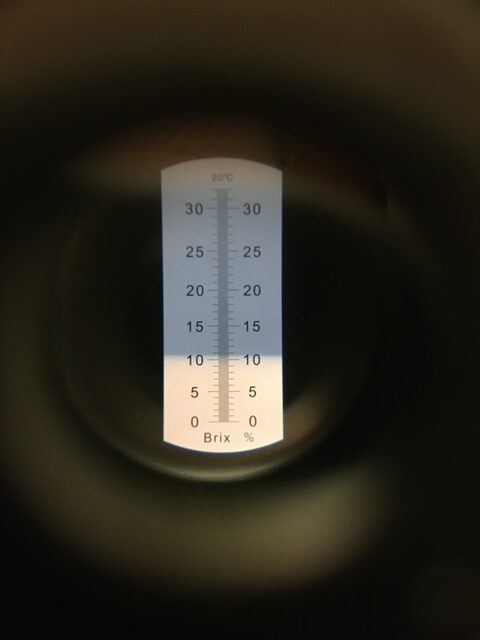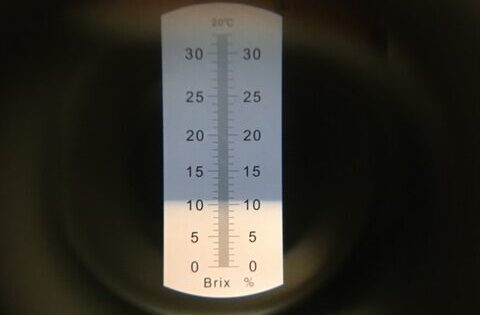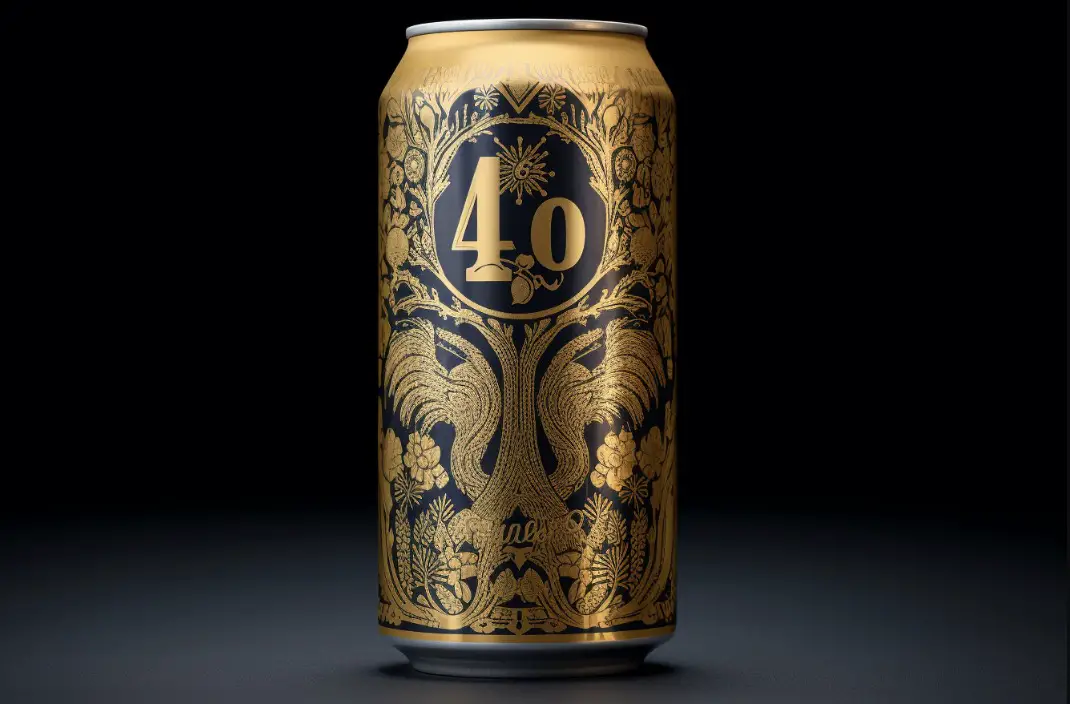A Brix refractometer is a powerful tool that allows brewers to measure the sugar content in their wort during the brewing process.
In this blog post, we will discuss how to properly read a Brix refractometer, the importance of accurate measurements, conversion to other units, and tips for getting the most out of your refractometer!
We will also explore the relationship between Brix and specific gravity, as well as how temperature can affect your readings.
In short: How to read a refractometer:
To read a refractometer for sugar content, follow these steps:
1. Ensure that the refractometer is clean and calibrated according to the manufacturer’s instructions.
2. Take a small sample of the liquid you want to measure, such as a fruit juice or syrup.
3. Place a few drops of the liquid onto the prism or sample plate of the refractometer.
4. Close the cover of the refractometer and hold it up to a light source.
5. Look through the eyepiece and focus until the boundary line between the light and dark areas is sharp.
6. Read the scale or digital display on the refractometer where the boundary line intersects.
7. The reading indicates the sugar content, usually expressed as Brix or percentage (grams per 100 grams).
8. Record the measurement if needed for further analysis or comparison. Some digital refractometers do this automatically.

Remember to consult your refractometer’s user manual for specific instructions, as different models may have slight variations in usage.
What is a Brix Refractometer?
A Brix refractometer is an optical instrument that measures the concentration of dissolved solids, specifically sugar, in a liquid solution.
ATC Dual Scale Refractometer

Best Value
Super affordable, sturdy refractometer that also shows SG-equivalent.
- Classic monocular design
- Dual scale (Brix and Specific Gravity)
- Comes with a practical storage case
- Very reasonable priced
It works by measuring the refractive index of the liquid, which changes as the sugar concentration increases.
This measurement is expressed as degrees Brix (°Bx), which represents the percentage of sugar by weight in the solution.
Why Use a Brix Refractometer?
Using a Brix refractometer provides several benefits for brewers:
– Quick and accurate measurements: A Brix refractometer allows you to quickly and accurately measure the sugar content in your wort, which is essential for determining the potential alcohol content of your finished beer.
– Small sample size: Unlike a hydrometer, a Brix refractometer requires only a few drops of liquid for a reading, which minimizes waste and contamination risk.
– Easy to use: Once calibrated, a Brix refractometer is simple to use and read, making it an accessible tool for brewers of all experience levels.
How to Calibrate a Brix Refractometer
Before using your Brix refractometer, it’s crucial to calibrate the instrument to ensure accurate readings. To do this, follow these steps:
1. Clean the prism: Wipe the refractometer’s prism with a soft, lint-free cloth to remove any dust or dirt.
2. Apply distilled water: Place a few drops of distilled water on the prism.
3. Close the daylight plate: Gently lower the daylight plate onto the prism, ensuring that the water covers the entire surface without any bubbles.
4. Adjust the calibration screw: While looking through the eyepiece, adjust the calibration screw until the boundary line between the blue and white areas aligns with the 0°Bx mark on the scale. Your refractometer is now calibrated.
Reading a Brix Refractometer
To read a Brix refractometer, follow these steps:
1. Prepare a wort sample: Collect a small sample of your wort in a clean container, ensuring that it is free of debris.
2. Allow the sample to cool: Temperature can affect your refractometer’s readings, so allow the wort sample to cool to room temperature before proceeding.
3. Apply the sample to the prism: Place a few drops of the cooled wort sample onto the refractometer’s prism.
4. Close the daylight plate: Gently lower the daylight plate onto the prism, ensuring that the wort covers the entire surface without any bubbles.
5. Read the Brix value: Look through the eyepiece and read the value on the scale where the boundary line between the blue and white areas intersects. This value is the Brix percentage of your wort.
Converting Brix to Specific Gravity
Many brewers prefer to work with specific gravity (SG) measurements rather than Brix. To convert your Brix reading to specific gravity, you can use the following formula:
`SG = 1 + (0.004 x Brix)`
Alternatively, you can find online calculators and conversion charts to assist with this conversion.
How Temperature Affects Brix Readings
As mentioned earlier, temperature can impact the accuracy of your Brix refractometer readings. Most refractometers are calibrated for use at a specific temperature (usually 20°C or 68°F). If your wort sample is significantly warmer or cooler than this, your readings may be slightly off.
To account for this, some refractometers come with automatic temperature compensation (ATC) technology that adjusts the readings for temperature variations. If your refractometer does not have ATC, you can use online temperature correction tools to adjust your readings accordingly.
Tips for Accurate Brix Readings
To ensure the most accurate Brix readings, follow these tips:
– Keep your refractometer clean: Always clean the prism and daylight plate before and after each use.
– Avoid bubbles: Ensure that your wort sample covers the entire prism without any bubbles, as this can affect your readings.
– Calibrate regularly: Calibrate your refractometer before each brewing session to ensure consistent accuracy.
– Consider temperature: Allow wort samples to cool to room temperature before taking readings, and be aware of any temperature corrections that may be necessary.
Digital vs. Analog Refractometers for Brewing: Pros and Cons
When it comes to refractometers for brewing, both digital and analog options have their distinct advantages and disadvantages. Let’s take a closer look at the pros and cons of each type to help you make an informed decision.
Analog Refractometers
Pros:
- Reliability: Analog refractometers have a long-standing reputation in the brewing industry for their reliability.
- Affordability: Analog models are generally more budget-friendly compared to their digital counterparts.
- No Power Dependency: Analog refractometers do not require batteries or power sources, making them always ready for use.
Cons:
- Manual Interpretation: Analog refractometers rely on a measurement scale, requiring manual interpretation, which can introduce human error and impact accuracy.
- Limited Features: They may lack advanced features such as automatic temperature compensation or data storage found in digital refractometers.
Digital Refractometers
Pros:
- Accuracy and Precision: Digital refractometers provide highly accurate and precise measurements, reducing the potential for human error.
- Readability: The digital display of measurements makes it easier to read and interpret the results.
- Advanced Features: Many digital models offer features like automatic temperature compensation, data storage, and unit conversion, enhancing convenience and efficiency.
Cons:
- Higher Cost: Digital refractometers are generally more expensive than analog ones, which can be a significant consideration for budget-conscious brewers.
- Power Dependency: They require batteries or a power source, meaning you need to ensure their availability for accurate measurements.
In summary, analog refractometers offer reliability and affordability, but they require careful manual interpretation and may lack advanced features.
Milwaukee MA871 Refractometer

Fast and accurate
Best Handheld Digital Refractometer
- Less than 2 second readout
- Feels sturdy and robust
- Easy to clean and calibrate
- 0-85% measurement range
On the other hand, digital refractometers provide accurate measurements, advanced features, and improved readability, but they come at a higher cost and require power sources.
Ultimately, the choice between digital and analog refractometers depends on your brewing needs, budget, and preference for convenience and precision. Consider weighing the pros and cons to determine which type aligns better with your specific requirements.
Conclusion
Understanding how to read a Brix refractometer is essential for any brewer looking to precisely measure the sugar content in their wort. By following these steps and tips, you can ensure accurate readings and improve your overall brewing process.
10 Facts About Brix Refractometers
1. A Brix refractometer measures the sugar content in a liquid solution.
2. The measurement is expressed as degrees Brix (°Bx), representing the percentage of sugar by weight.
3. Brix refractometers offer quick and accurate measurements with a small sample size.
4. Calibration is crucial for accurate readings.
5. Converting Brix to specific gravity is simple using calculators or conversion charts.
6. Temperature can affect Brix readings, so always allow samples to cool before measuring.
7. Some refractometers come with automatic temperature compensation (ATC) technology.
8. Always keep your refractometer clean and avoid bubbles in your samples for the most accurate readings.
9. Calibrate your refractometer regularly to maintain consistent accuracy.
10. Brix refractometers are an invaluable tool for brewers of all experience levels.
FAQs
In what unit do refractometers measure sugar concentration?
Refractometers measure sugar concentration in units of Brix.
What do you mean by 20% Brix of sugar?
20% Brix of sugar refers to a measurement of the sugar content in a solution. Brix is a unit of measurement commonly used in the food and beverage industry to quantify the amount of dissolved solids, primarily sugar, in a liquid. A 20% Brix solution contains 20 grams of sugar per 100 grams of solution.
How much sugar is 1 Brix?
Brix is equal to 1 gram of sugar per 100 grams of solution.
How do you convert Brix to sugar?
To convert Brix to sugar, you can use a conversion chart or formula. The Brix scale measures the sugar content in a solution, so the conversion involves determining the sugar concentration. The most common method is to use a refractometer to measure the Brix value and then apply a conversion factor to estimate the sugar content.
The conversion factor varies depending on the specific product, such as fruit juice or wine, as different sugars have different levels of sweetness. It’s important to note that the conversion is an estimation, as other factors like acidity and temperature can influence the accuracy.




